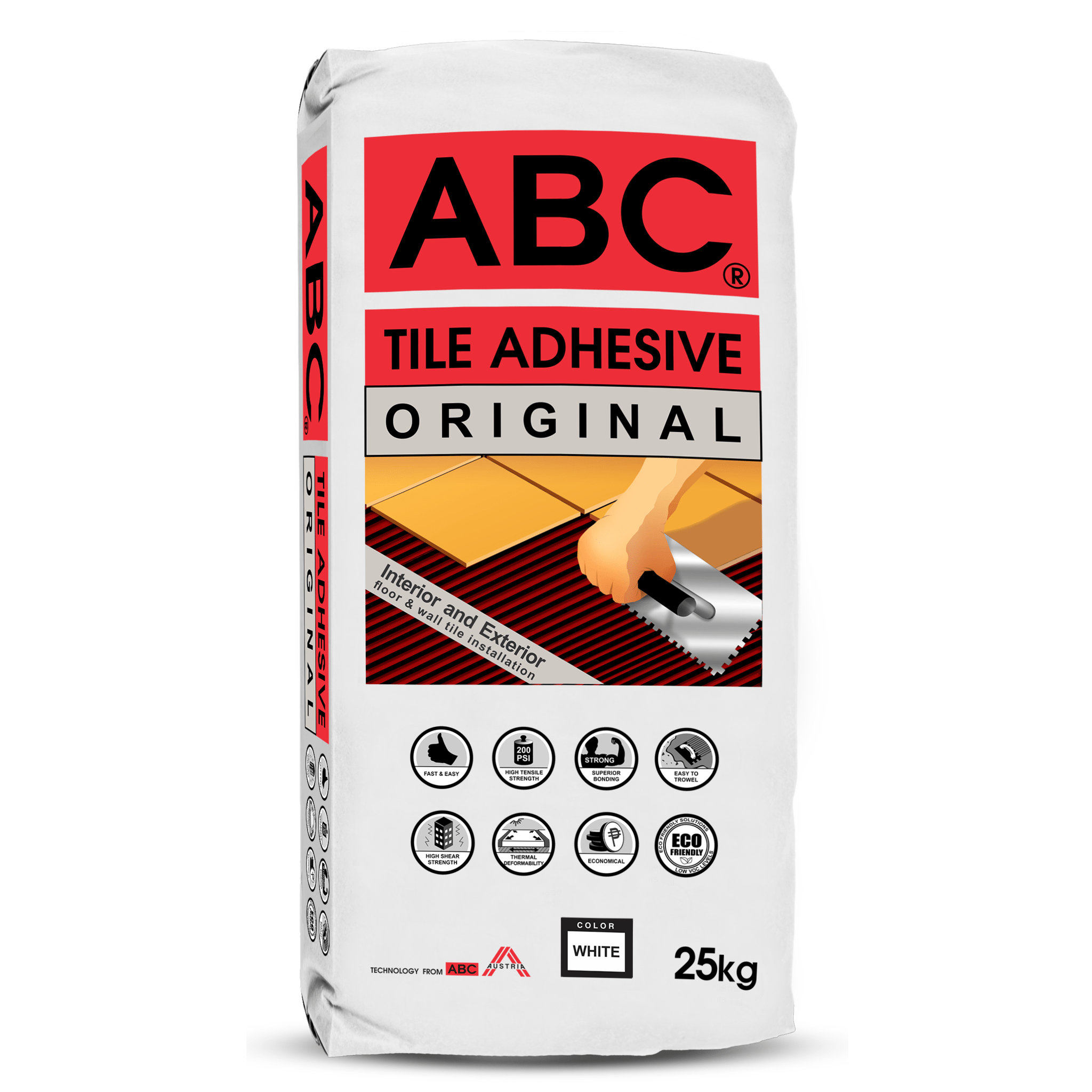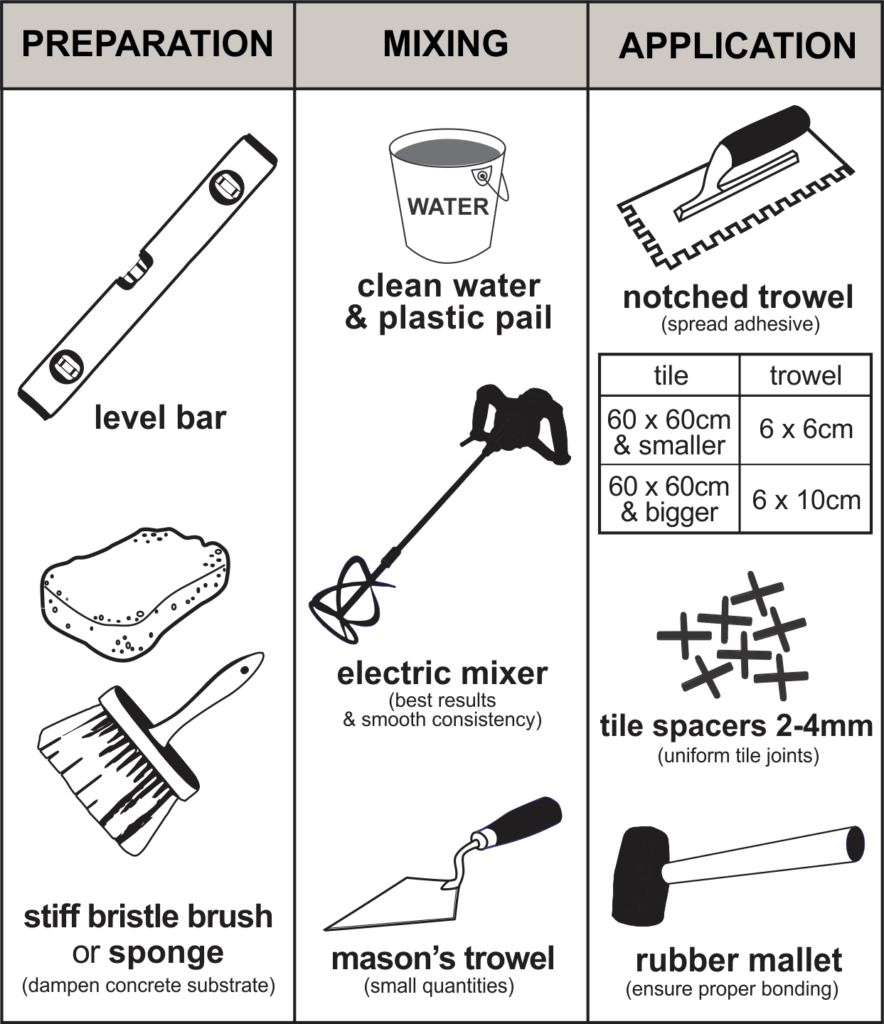
ABC TILE ADHESIVE Original is a cement-based adhesive designed for bonding all sizes of earthenware tiles for floor and wall tile installations. Only high quality aggregates and selected chemical additives are used strictly conforming to International Standards.
Tile installations on indoor & outdoor concrete surfaces for all sizes of earthenware tiles (ceramic & clay tiles) and mosaic tiles (porcelain & stoneware mosaic).
PROPERTIES
- Fast & easy application & installation
- High tensile adhesive strength (200 PSI)
- High performance
- Easy to trowel (achieve 100% mortar coverage for best results)
- High shear strength (withstands minor structural movements caused by moving loads)
- Resistant to thermal deformation (adapts to temperature change)
- Economical (high productivity, achieve more in less time)
- Eco-friendly (low Volatile organic compound levels)
Concrete surface must be fully cured, structurally stable, level, clean and free of paint and contaminants such as dirt, dust, loose material, oils, chemicals, etc.
| Substrate | Surface Preparation |
|---|---|
| New concrete | Concrete must have fully cured (28 days) |
| Waterproofed concrete | Cementitious waterproofing must have cured 3 days (conduct flood/leak test if needed) |
| Painted concrete | Abrade paint (w/ steel brush and paint remover) |
| Smooth concrete | Apply scratch coat to roughen surface |
| Repair work | Remove old loose tile & concrete mortar |
TOOLS

COVERAGE
| COVERAGE of 25kg Tile Adhesive Original (approx.) | ||
|---|---|---|
| Tile Size | Adhesive Thickness | Area |
| 30 x 30cm & smaller and mosaic tiles | 3 mm | 5 m² |
| 60 x 60cm & smaller | 6 mm | 2.6 m² |
| NOTE: Coverage is dependent on tile size, surface smoothness of the back of the tile, substrate condition and adhesive application thickness. The bigger the tile, the smaller the coverage area. | ||
How to use ABC Tile Adhesive Original
1. Mixing (Mix in plastic pail)
MIXING RATIO
Method Water Tile Adhesive
Mechanical (Electric Mixer) 5.25 L 25 kg
Manual (Mason's Trowel) 6 L
Pour water in a plastic pail & add Tile Adhesive Original. Mix 2-3 minutes to attain a smooth, lump-free & pasty consistency. Let mixture rest for 15 minutes. Mix again briefly before use. (NEVER mix old batch with new batch.)
Tagalog: Maglagay ng tubig sa plastik na timba at idagdag ang Tile Adhesive Original. Haluin hanggang sa maging malapot at mawala na ang pamumuo ng tile adhesive. Maghintay ng 15 minuto bago muling haluin at gamitin. (Huwag paghaluin ang luma at bagong gawang halo.)
POT Life: 4 hours
2. Application (Apply adhesive mortar with notched trowel)
Apply tile adhesive mortar with a notched trowel combing in a straight manner 1m2 at a time. For large format tiles or tiles with a smooth back surface, apply a scratch coat at the back of the tile & let dry before using the double spreading adhesive method. (Dampen concrete surface before adhesive application.)
Tagalog: Sa isang metro-kuwadrado kada latag, ipahid ang tile adhesive nang deretsong direksyon. Para sa mga malalaking tiles at tiles na sobrang kinis ang likuran, pahiran muna ito ng scratch coat at patuyuin bago mag-pahid ng adhesive. Ipahid ang adhesive sa likod ng tiles at sa kongkreto. (Basain ang kongkreto bago magpahid ng tile adhesive.)
3. Installation (Install tiles with tile spacers & rubber mallet)
Install tiles within 20 minutes mortar open time. Use tile spacers for proper alignment. Position and adjust tiles within 15 minutes. (Foot traffic after 24 hours)
Tagalog: Idikit ang tiles nang hindi lalampas ng 20 minutong open time. Pagkadikit, ayusin at ihilera ang tiles sa loob ng 15 minuto. (Foot traffic after 24 hours)
TIPS:
- Do random checks if the back of the tiles are fully covered with tile adhesive.
- Check if tile adhesive mortar still adheres to your finger to find out if the open time has not lapsed. If open time has lapsed, remove old tile adhesive layer and reapply a new one to avoid bonding failure.
- NEVER add newly prepared tile adhesive to a previously mixed batch.
- Use tile spacers for uniform grout lines. A tile joint width is needed to accommodate possible tile movement due to thermal deformation, substrate shrinkage or tile expansion, thus preventing the tile from cracking.
Packaging: 5 kg plastic bag and 25 kg multilayer paperbag
CLEANING / SAFETY / STORAGE / SHELF LIFE
Use clean water to remove excess tile adhesive on tile surface and tools before it hardens. Non-toxic. Do not inhale or ingest. As with any cementitious material, avoid eye exposure and prolonged skin contact. In case of irritation, rinse with sufficient water. If symptoms persist, consult your doctor. Store in a cool dry place. In its original unopened packaging, this will remain usable for a period of one year from date of manufacture.
WARRANTY
Due to the variety of applications, the differing methods of working, the various properties of bases, etc., we cannot assume responsibility or liability with regard to the application of our products. Our guarantee and liability is restricted to the quality of our products at the time of acceptance of the customer of such products. In no case shall our liability extend beyond replacement of defective products, if any, found at the time of acceptance. For all deliveries and services, our General Sales Condition, including warranties stipulated for each case are valid.

